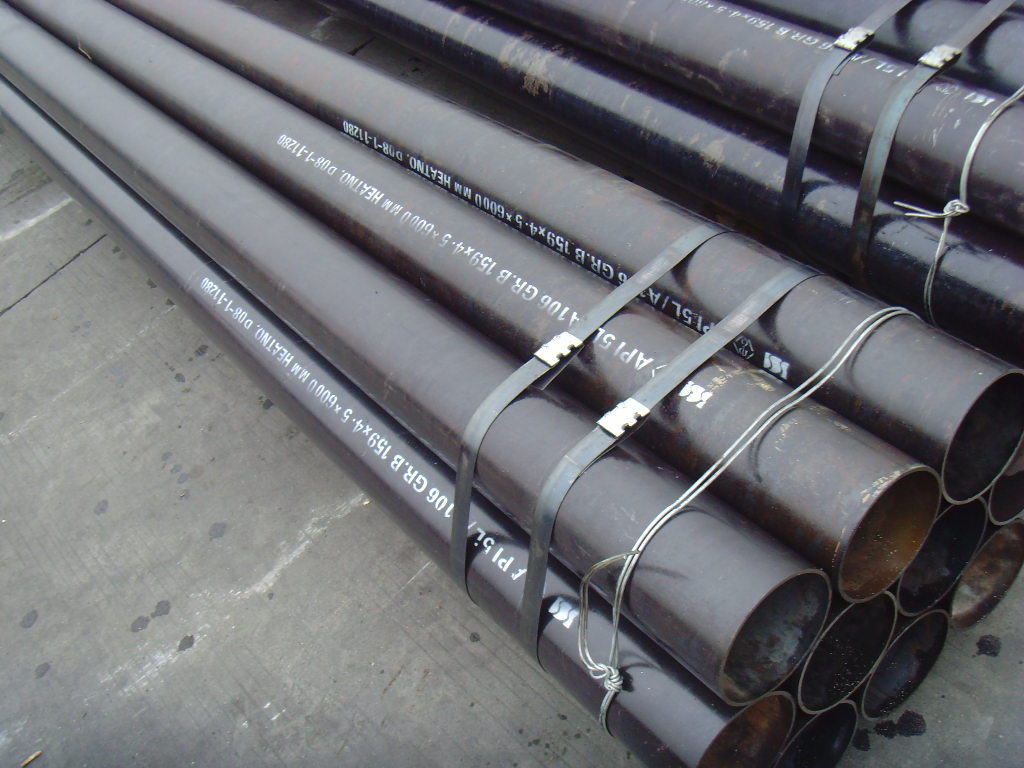deformation theory of cold rolling tube process
Home >
-
API steel pipe
- API steel pipe
- API steel casing pipe
- Casing and Tubing
- API drill pipe
- API5L steel pipe
- Oil pipeline

-
Carbon steel pipe
- Carbon steel pipe
- Welded steel Pipe
- seamless carbon steel pipe
- Petroleum Casing Pipe

-
Alloy steel pipe
- astm a 335 gr p22
- alloy steel pipe l555
- 25crmo4 alloy steel pipe
- alloy pipe a335 p11









One of the Top 500 enterprises in China foreign trade
QCCO was approved as a member of “China Association for Contracting Projects Abroad “and granted a membership certificate on Sep 28,2005; “Credibility Rating AAA certificate in Foreign Trade” was granted to QCCO by China Shippers’ Association
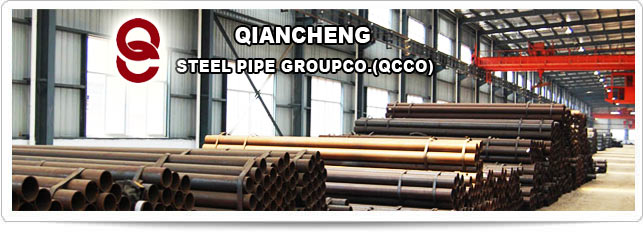
deformation theory of cold rolling pipe process
The basic theory of cold-rolled pipe pipe rolling process, deformation and stress state, instantaneous deformation District, slip and axial force, rolling force.
pipe rolling process of the two-roll cold rolling mill roll cold rolling mill, the work rack by means of a crank linkage for reciprocating. The rolling of the pipe (Figure 1) is carried out between the block 5 of a screwed on the mandrel rod 7 is fixed and a tapered mandrel, and the two rolling grooves. Open in the circumference of the groove block radius from large to small changes in the Hole. Grooved at the beginning of the radius equivalent to the radius of the pipe material 1, and with its end of the radius equal to the radius of the rolled into a pipe 2.
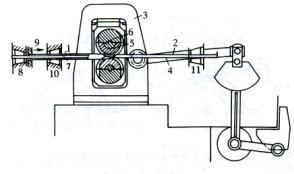
Figure 1 two-roll cold rolling mill
1 - pipe material; 2 - rolled into a pipe; 3 - Working rack; 4 - crank linkage; 5 - groove block
6 - roll; 7 - mandrel rod; 8 - mandrel rod chuck; 9 - pipe chuck; 10 - intermediate chuck; 11 - chuck
During feeding and is rotated, the hole and the tubular body is not in contact with this end, in the front and rear of the grooved portion on the groove block 5, respectively processing of a certain length of the feed opening (radius than the radius of the pipe material large) and the rotary openings (radius larger than the radius of the pipe rolled into). In the rolling process, the pipe material and the mandrel is pinched by the chuck 8,9, therefore, both in the the positive travel rolling or the round trip time of rolling, the pipe material can not move axially.
Working rack by the rear limit position to move to the front limit position positive stroke; work moved to the rack by the front limit position limit position for the return trip.
Rolling process, when the limit position after working rack to move the pipe material sent to a short, saying that the amount of feed. Work rack is moved forward after the just-fed pipe material and the original in the tubular body between two limit positions of the work rack, is not yet finished processing constituted by the hole and the mandrel is gradually reduced in size in the annular gap in reduced diameter and wall pressure. When the work rack is moved to the front limit position, the pipe material and the mandrel together with the rotary 60 . ~ 90 . . Working rack reverse mobile pipe ran over positive travel by pass continue rolling are whole and rolled into the part of the pipe. Rolled into a part of the pipe next pipe material feed from the mill.
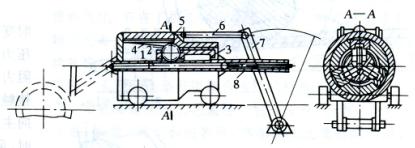
Figure 2 multi-roll cold rolling mill
1 - cylindrical mandrel; 2 - rolls; 3 - roll stand; 4 - support plate; 5 - thick-walled sleeve; the 6 - Dalian rod; 7 - rocker; 8 - pipe
Multi-roll cold rolling mill pipe rolling process of multi-roll cold rolling mill rolling pipe (see Figure 2), the pipe 3 to 4 in the groove of the radius of the cylindrical mandrel and engraved roll. between deformation. Rolls mounted in the roll stand 3, the roll neck 4, a support plate mounted on the thick-walled sleeve 5 is pressed against a shaped support plate (slide), while the thick-walled sleeve itself is the mill rack, It is installed in a small car. Work, the crank rod and the rocker respectively, driven roll stand for the trolley and mounted in the work rack to reciprocally move. Since the trolley and a roll stand by Dalian rod 6 and the small connecting rod is linked to the rocker 7, so when the rocking of the rocker, the rolls and the support plate will produce relative movement. When the roll diameter for reciprocating rolling on the surface of the support plate having a certain shape, the annular grooved roll and a cylindrical mandrel from large to small, for periodically changing from small earth. When the car come to the limit position of the rear plate, the feed a certain length of pipe material and the tubular body is rotating at an angle. In order to reduce the axial force in the rolling of the round trip to prevent two adjacent pipe material in the end portions are cut, the general feed and the rotation of the tubular body of the pipe material, is when the baby carriage in the rear limit position simultaneously. When the limit position after the forward movement of the trolley left, pass gradually becomes smaller, and subjected to rolling, obtained when the round trip rolling are rounded.
Cold-rolled pipe deformation and stress state of the metal pipe rolling two-roll cold rolling mill, for example, the deformation process of the metal pipe rolling process is shown in Figure 3. Feed cone is moved to the rolling direction a distance m (feed amount), is equivalent to pipe material I - I sectional mobile same distance to the I- 1 - Ⅰ 1 position, Ⅱ Ⅱ in cross section to move the same distance m Ⅱ Ⅱ 1 position (Figure 3a). When fed in the pipe material, the inner surface of the cone of work from the surface of a mandrel, a clearance C is formed between the two, when the work rack forward, the work cone is deformed in the deformation zone in the first The reduced diameter, and then is pressed to the wall (Fig. 3b), but also in the process of deformation and extending in the gap between the inner surface of the work cone located in front of the groove block mandrel increasing. At the same time, the working end of the cone section Ⅱ x - Ⅱ x position to move to .
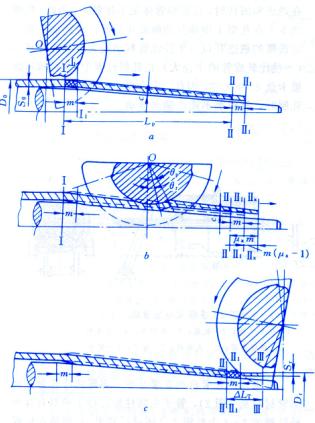
Figure 3 cold-rolled pipe metal deformation
In the return stroke of the rolling, rotating by an angle due to the tubular body prior to rolling, the original metal in the grooved sidewall Go grooved top, and thus the work cone by are rounded, so that any one of the cross-sectional shape more rounded, the wall thickness more uniform. Further, since the deformation, wherein the part of the metal to the results of the flow to the periphery, in the grooved sidewall and the inner surface of the working cone pipe material from the mandrel, which is conducive to the next pipe material feed.
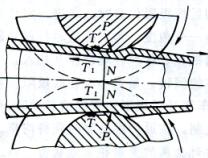
Figure 4 cold pipe deformation forces
Limit position I, after the back of the work rack, one end of the rolling cycle, rolled into a pipe of a length of △ L T (Figure 3c):
L △ T =% 26pi: S 0 (D 0 -S 0 ) m /% 26pi: S T (D T , S T ) =% 26mu; % 26epsilon; m
Wherein% 26mu; % 26epsilon; total extension coefficient is equal to the pipe material the cross-sectional area and rolled into a pipe cross-sectional area ratio, m is the feed amount. Total extension coefficient% 26mu; % 26epsilon;, and the larger the amount of feed m; △ L T greater the contrary △ smaller the L T .
Cold-rolled pipe, the metal is constantly changing position and shape of the the instantaneous deformation zone deformation. Metal in the positive pressure of the roll P, the positive pressure of the mandrel, the frictional resistance of T from the roll and from frictional resistance T 1 mandrel role of N deformed (Figure 4). Take a unit body, the deformation of the contact area of the metal roll radial principal stress% 26sigma; 1 week to the principal stress% 26sigma; 2 and axial principal stress% 26sigma; 3 are compressive stress, so cold-rolled pipe , the basic stress the stress state of the metal deformation is three to compressive stress, but at the roll gap (% 26phi; angular range) axially withstand the unidirectional tensile stress, see Figure 5. Compared with the stress state always pull to the pressure in the cold-drawn pipes, such a state of stress is more conducive to the the metal plasticity of play.
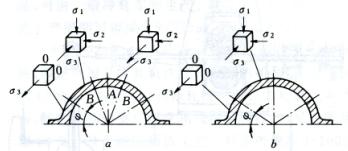
Figure 5 along the groove of the state of stress in the cold-rolled pipe deformation maps
a-regular trip; b-anti-stroke
The structure of the instantaneous deformation zone regardless of stroke is rolling or return trip rolling the instantaneous deformation zone outlet section coincides with the work of the center of the rack-section. Reduced diameter pipe rolling in on a two-roll cold rolling mill, the first pipe into the deformation zone and then reduced wall thickness, therefore, the instantaneous deformation zone, including reducing angle% 26theta; p and pressure angle% 26theta; t constituted of two parts (Figure 3b). In the working stroke of the rack% 26theta; p ,% 26theta; the size of t is changed. % 26theta; to constitute the instantaneous deformation Chief contact angle p t and with% 26theta; . pipe rolling in the multi-roll cold-rolling pipe on the stage of the beginning of the stroke instantaneous deformation zone is constituted by a single reduced diameter area in the other parts of the stroke, due to this mill using a cylindrical mandrel, the instantaneous deformation zone can be considered by a single Less wall region constitutes.
Determination of the amount of deformation of the instantaneous deformation zone in the general longitudinal rolling process, the geometry of the deformation zone is constant. Blank either a cross-section could have been moved from the entrance of the deformation zone to the exit. The difference in height of the inlet section and outlet section of the deformation zone, and continuously passed through the deformation zone is the material assumed a cross-sectional reduction, but is constant. But in the cold-rolled pipe into the deformation zone and leave the size of the pipe cross-section of the deformation zone is changing, and the height difference of the inlet section and the outlet section of the instantaneous deformation zone that does not mean that work on cone into the cross-section of the instantaneous deformation zone the amount of reduction in a rolling stroke. Therefore, when the cold-rolled pipe, any section on the work cone continuously in a rolling stroke by changing the instantaneous deformation zone reached by the amount of deformation is not the same, and to determine its size is relatively complex. Export section sizes in the actual calculation, usually based on the instantaneous deformation zone, to determine the location and size of the beginning of the section deformation work cone, and then calculate the amount of deformation. The amount of deformation is called the the instantaneous deformation zone deformation amount. The calculation of the amount of instantaneous deformation zone deformation is generally based on the following principles: the export section set up an instantaneous deformation zone Ⅰ - Ⅰ (Figure 6), the reduction is equal to the cross-section through instantaneous deformation zone experienced it with another II Ⅱ in height in cross section, while the volume of metal included in between these two cross-section is equal to the feed volume of metal. R x , R x, and S x the instantaneous deformation zone outlet cross-section of the outer radius, inner radius and wall thickness; R % 26Delta; x , r % 26Delta; x and S % 26Delta; x respectively, of the cross section deformation the outer radius, inner radius and wall thickness.
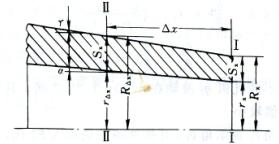
Section in Figure 6 Cartesian coordinate work cone
When the cold-rolled pipe, the main deformation is completed; positive travel rolling process However, since the the work rack: rolls and other parts of the elastic recovery, and the rotation of the pipe body before rolling, and some mill also fed Therefore, in the round trip rolling work cone also has some even larger deformation.
Generally can use the following formula to calculate the positive stroke rolling and return stroke rolling thickness reduction

式中%26Delta;Sn为正行程轧制时的壁厚压下量;%26Delta;So为返行程轧制时的壁厚压下量:Vy=(R0+r0)/(Rx+rx)mSx为送进体积率;R0、r0为管料的外半径和内半径;%26alpha;为锥形芯棒的母线倾斜角;%26gamma;为工作锥母线的倾斜角;Kt为计算返行程轧制时变形量的系数,一般可取Kt=0.3~0.4。
A wall thickness reduction in the rolling cycle is:

The instantaneous deformation zone boundary and bite angle for calculation of the deformation, the contact area with the rolling roll, you must know the front and rear boundary line of the instantaneous deformation zone. Cycle-style rolling, the the instantaneous deformation zone behind the boundary (outlet side of the boundary line) should be a space curve, but in fact little difference and mill center plane and the line of intersection of the cone, it is generally the latter as the instantaneous behind the boundaries of the deformation zone.
The instantaneous deformation area of the front boundary (boundary line) of the inlet side is a space curve, it depends on each longitudinal cross section of the deformation zone along the periphery of the grooved contact angles% 26theta of; 0 . (Figure 7)
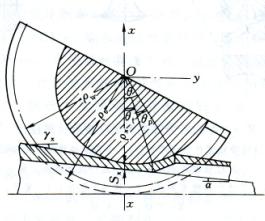
Figure 7 instantaneous deformation zone is a vertical cross-sectional
% 26theta; calculated according to the following simplified formula:

In the a grooved ridge portion, the contact angle is:

Wherein% 26rho; r for the radius of the roll pass ridge portion.
Instantaneous deformation of the contact area of Figure 8 for the two-roll and multi-roll cold rolling mill rolling the pipe deformation zone and the contact area icon.
Literature, a variety of approximate formulas to calculate the instantaneous deformation zone contact area. The method of contact area in a common calculation of the two roll pipe rolling of the cold pilger mill follows.
Figure 9 is the contact angle by means of calculated% 26theta; positive stroke rolling the instantaneous deformation zone contact surface area of the vertical projection and horizontal projection. The region OPLMC of the vertical projection of the surface area of the total contact; the OPRE = F y s as a Less-wall region of contact with the vertical projection of the surface area; 1 NM 2 L 1 L 1 M 2 B 2 = f D x with the level of the total contact surface area of the projection; C 1R1 PR 2 C 2 = F x s Save wall region contacting the surface area of the horizontal projection.
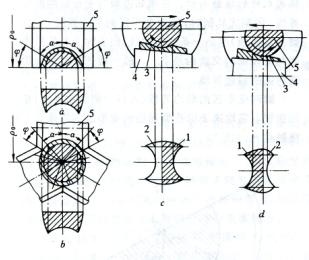
Figure 8 cold rolled steel pipe deformation zone and the contact area icon
a-two-roll cold rolling mill deformation zone; b-multi-roll cold rolling mill deformation zone; contact area of the c-positive travel; d-return stroke of the contact area
1 - plastic and elastic deformation zone; - elastic deformation zone; 3 - pipe; 4 - mandrel; 5 - roll
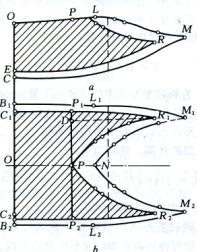
Figure 9 positive stroke rolling the instantaneous deformation zone contact area
a-vertical projection; horizontal projection of b-
Less wall area to determine the first contact with the surface area of the horizontal projection. Figure 9, less wall region of the horizontal projection surface area of contact can be divided into two parts:
F x s = 2 (F c1p1po + F p1R1P )
Grooved ridge portion C = R x area F c1p1po, is calculated by the following formula having a sufficient accuracy:

Wherein C is a deep slot holes, approximately half of the hole groove width.
Fp1R1P=%26eta;1 1/2(P1P)(R1D),

Since the opening angle of the grooved sidewall is usually 16 . ~ 22 . The engineering calculation desirable for C min = R x . / 3 Hole peripheral work cone first point of contact at the total contact angle:

The grooved ridge portion of the total contact angle:

Therefore

26theta; tc / 26theta%, tr =% 26theta; oc /% 26theta; or =% 26eta; 2
Different mill% 26eta; fluctuations between 1.60 to 1.70, the mill when its value is small.

Where% 26eta; contact area shape coefficient, two-roll cold rolling mill, a value of 1.20 to 1.25; desirable to 1.10 for the three-roll cold rolling mill.
The corresponding reduction in the wall region the total contact surface area can be determined as follows:

The last two equations% 26Delta; the R x replaced △ S x , you can obtain the horizontal projection of the total surface area of contact and the total surface area of contact.
A slip in the rolling process and the axial force exists between the metal and the surface of the rolling groove in the process of cold-rolled pipe, the relative sliding i.e. slip. Deformation zone by the forward slip zone and after the slide area. Front slip zone acting on the metal friction in the rolling process (Figure 10, T- x2 ) in the direction and moving the rack in the direction opposite; (Figure 10 after the slip area ABC acting on the metal friction T x1 ) direction and in the same direction as the rack moves.
Not applied before and after the tension generally simple longitudinal rolling process, the role of a positive pressure on the metal of the roll in the deformation zone of the axial component and the axial component of the frictional force acting on the front and rear sliding zone always balance each other. In this rolling process, the exit velocity of the rolling member based on the deformation condition and automatically changes with respect to a certain deformation conditions, there must be a corresponding exit velocity to form the appropriate front and rear sliding zone, so that when the front and rear sliding zone by the axial component of the frictional force generated coincides with the axial component of the roller positive pressure equilibrium.
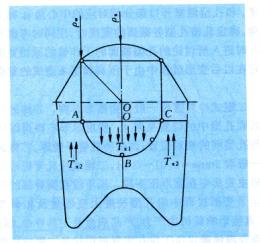
The direction of the horizontal projection of the contact area and friction of Figure 10 before and after the slip zone
Mandatory due to the rolling process, cold-rolled pipe (pipe feeding is fixed and can not for axial movement) does not exist before and after the slide area size may be adjusted by changing the speed of rolling exports. Therefore, under normal circumstances, the role of the axial component of the forces on the deformation zone can not be mutually balanced, As a result, in the subject to the axial force from the deformation tool during deformation of the tubular body. Sometimes axial force is quite large. The axial force on the work rack stroke length distribution is uneven, and the maximum axial force is often not corresponding with the maximum rolling force. In positive stroke when rolling, the axial force may be a pressure (direction and work cone extending in opposite directions) or tensile force (direction and work cone extending in the same direction); usually occurs only axial pressure when the round trip rolling. Axial force the General Assembly of the rolling process to produce adverse effects such as two ends of adjacent pipe material is cut into each other, the the mandrel rod longitudinal bending, the work cone rolling process ran feed pipe material work cone mandrel disengaged when the resistance is increased, and increased wear of advancing mechanism, and the like. Therefore, the size of the axial force in a certain extent, determines the productivity and to achieve the amount of deformation of the rolling mill.
Rolling force on a two-roll cold pilger mill, and the rolling force of the metal acting on the rolls on the average can be calculated as follows:

Wherein K % 26delta; with rolling metal hardening coefficient related to steel it is desirable for 1.42;% 26delta; B50 for the degree of deformation of the ultimate strength of the metal in the 50%; D 0 is a diameter of the pipe material; D T is rolled into a pipe diameter; average radius of R c groove depressed segment roll; L c for a reduction of the length of a rolling groove; the wall thickness of the S o for the pipe material; S T is rolled into a pipe wall thickness. Multi-roll cold rolling mill, the average rolling force is calculated as:

Where K as multi-roll cold rolling pipe deformation characteristics relevant coefficient is generally desirable for the 1.6 to 2.2;% 26delta; the average bc intensity limit for deformation around the pipe; R k is rolling radius; l pk reduction of the length of cone.
Note: If you feel the cold-rolled pipe deformation theory is helpful to you, you can share with your friends about!
Articles represent the personal point of view, inevitably some bias hysteria, users table to make comments, let us improve, learn from each other progress.

